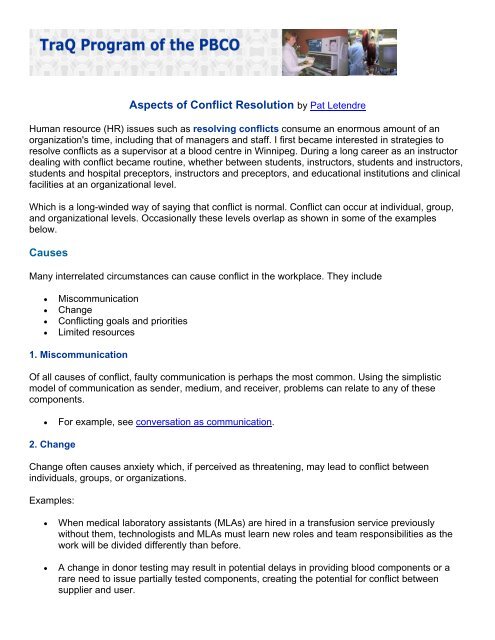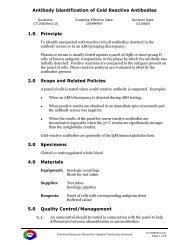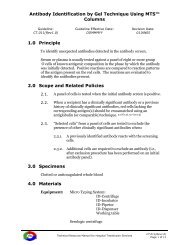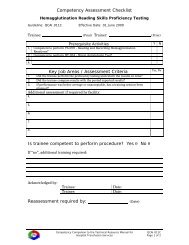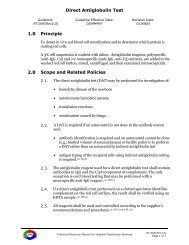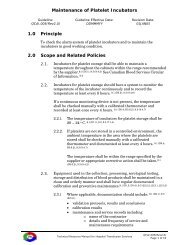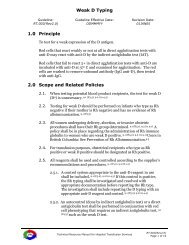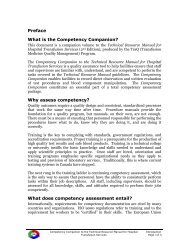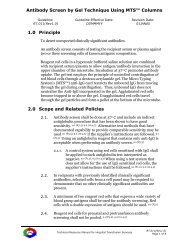Aspects of Conflict Resolution
Aspects of Conflict Resolution
Aspects of Conflict Resolution
You also want an ePaper? Increase the reach of your titles
YUMPU automatically turns print PDFs into web optimized ePapers that Google loves.
<strong>Aspects</strong> <strong>of</strong> <strong>Conflict</strong> <strong>Resolution</strong> by Pat Letendre<br />
Human resource (HR) issues such as resolving conflicts consume an enormous amount <strong>of</strong> an<br />
organization's time, including that <strong>of</strong> managers and staff. I first became interested in strategies to<br />
resolve conflicts as a supervisor at a blood centre in Winnipeg. During a long career as an instructor<br />
dealing with conflict became routine, whether between students, instructors, students and instructors,<br />
students and hospital preceptors, instructors and preceptors, and educational institutions and clinical<br />
facilities at an organizational level.<br />
Which is a long-winded way <strong>of</strong> saying that conflict is normal. <strong>Conflict</strong> can occur at individual, group,<br />
and organizational levels. Occasionally these levels overlap as shown in some <strong>of</strong> the examples<br />
below.<br />
Causes<br />
Many interrelated circumstances can cause conflict in the workplace. They include<br />
<br />
<br />
<br />
<br />
Miscommunication<br />
Change<br />
<strong>Conflict</strong>ing goals and priorities<br />
Limited resources<br />
1. Miscommunication<br />
Of all causes <strong>of</strong> conflict, faulty communication is perhaps the most common. Using the simplistic<br />
model <strong>of</strong> communication as sender, medium, and receiver, problems can relate to any <strong>of</strong> these<br />
components.<br />
<br />
For example, see conversation as communication.<br />
2. Change<br />
Change <strong>of</strong>ten causes anxiety which, if perceived as threatening, may lead to conflict between<br />
individuals, groups, or organizations.<br />
Examples:<br />
<br />
<br />
When medical laboratory assistants (MLAs) are hired in a transfusion service previously<br />
without them, technologists and MLAs must learn new roles and team responsibilities as the<br />
work will be divided differently than before.<br />
A change in donor testing may result in potential delays in providing blood components or a<br />
rare need to issue partially tested components, creating the potential for conflict between<br />
supplier and user.
New safety standards that require many changes in how transfusion services operate may<br />
trigger conflict between those affected and the regulator.<br />
When a new system <strong>of</strong> competency assessment is instituted, staff may perceive that<br />
management sees some <strong>of</strong> them as incompetent.<br />
A change in shift scheduling that requires staff to start work much earlier than usual may cause<br />
resentment among staff with school-age children.<br />
3. <strong>Conflict</strong>ing goals and priorities<br />
The goals and priorities <strong>of</strong> groups and organizations do not always coincide, thus creating the<br />
potential for conflict.<br />
Examples:<br />
<br />
<br />
<br />
<br />
In times <strong>of</strong> financial restraints management may want to minimize expenditures by maintaining<br />
many casual employees who do not qualify for staff benefits, whereas staff naturally want to<br />
qualify for benefits.<br />
A blood supplier may want to maintain a large central supply <strong>of</strong> blood so as to supply all<br />
clients, whereas individual hospital transfusion services may want to keep a large on-site<br />
supply for its own patients.<br />
A staff member who habitually comes to work late, takes excessive breaks, and leaves without<br />
informing others <strong>of</strong> work in progress, will cause conflict and resentment with co-workers.<br />
Transfusion services invariably want to arrange workload to coincide with staff schedules by<br />
requiring blood specimens to be collected during the day except for emergencies. Nursing and<br />
medical staff may not have this as a priority.<br />
4. Limited resources<br />
Lack <strong>of</strong> resources is a common cause <strong>of</strong> conflict in organizations. It may lead to competition for<br />
scarce funding, to discontent with working conditions, and more. Examples:<br />
<br />
<br />
<br />
One laboratory department may receive more funding for capital equipment than another,<br />
resulting in bad feelings and allegations <strong>of</strong> favoritism.<br />
When employer funding for continuing education and conferences is cut, more applications<br />
than can be supported will create the potential for competition and charges <strong>of</strong> favoritism.<br />
Workload may increase concurrent with staff reductions, requiring staff to do more with less.<br />
Approaches to resolving conflict<br />
Quality guru W. Edwards Deming coined the popular term "Win-Win" (as opposed to "I Win- You<br />
Lose") to describe a positive negotiating approach. Strategies for how to resolve conflict can be<br />
organize around variations <strong>of</strong> win-win:<br />
Win - Win<br />
The ideal outcome <strong>of</strong> conflict resolution is when both sides come to a mutually agreeable<br />
decision. Results from collaboration and compromise, but compromising only on minor points<br />
<strong>of</strong> contention.<br />
Win - Lose<br />
One side is satisfied with the outcome while the other side feels that it has lost and is<br />
dissatisfied. Results from competition in which the winner takes all.
Lose - Win<br />
One side gives way. Results from accommodation by one side to preserve a relationship or<br />
when they realize their position is untenable.<br />
Lose - Lose<br />
Both sides are dissatisfied with the outcome. Results from avoiding dealing with the real<br />
problems and making compromises on important issues.<br />
No deal<br />
Both sides agree to disagree, and no decision is made. Not necessarily lose-lose if a resolution<br />
is not urgently required.<br />
Techniques and strategies<br />
To identify and help resolve conflicts, try these techniques and strategies:<br />
1. Identify latent conflicts before they become overt. It helps for managers to keep attuned to staff<br />
issues by practicing "management by walking around" and taking c<strong>of</strong>fee breaks with technologists<br />
rather than always with other supervisory staff.<br />
2. Analyse the source <strong>of</strong> the conflict. The obvious signs <strong>of</strong> conflict may not be the real ones and<br />
people may have different views <strong>of</strong> what the issues are.<br />
<br />
Example: A group <strong>of</strong> technologists complain to the manager that Alice went to a conference<br />
two years in a row but the broader issue may be that the staff believe the manager practices<br />
favoritism routinely in terms <strong>of</strong> holiday scheduling and promotion.<br />
3. Identify the risks involved in unresolved conflict for individuals, groups, and the<br />
organization. The longer that conflict goes unresolved, the more likely it is that differences will grow<br />
or solidify.<br />
<br />
Example: A technologist has started to arrive late, take excessive breaks, and leave without<br />
informing others <strong>of</strong> work in progress. If supervisors do not deal with this issue promptly, the<br />
consequences could include (1) the unacceptable behavior becomes entrenched and habitual;<br />
(2) staff resentment grows and results in non-cooperation and overt hostility; (3) morale in the<br />
lab decreases; (4) patient safety is compromised.<br />
4. Understand the other person's perspective through active and empathetic listening. It is<br />
more important to listen than be heard, especially at first. Only after the other side's views are<br />
understood can win-win solutions be attempted.<br />
<br />
Example: Lab supervisor to head nurse: "The blood bank cannot accept late samples as we<br />
haven't the evening staff to process them. You will have to get them drawn earlier or blood will<br />
not be available for morning surgeries." versus "Samples from ward A4 have been arriving late<br />
recently. Has there been a change that's causing this--a new intern or resident? Increased<br />
work load? Can we work together to solve this?"<br />
5. Focus on issues, not personalities. Focusing on personality creates defensive behavior,<br />
whereas dealing with issues is less threatening.<br />
<br />
Example: Lab supervisor: "Alice, you are not carrying your load." versus "Alice, I have noticed<br />
that you have been coming in late recently and taking longer breaks. Has something<br />
happened?"
6. Build trust by being true to those who are absent, as advocated by Steven Covey in The Seven<br />
Habits <strong>of</strong> Highly Effective People. Being true to those who are absent means never discussing one<br />
staff member in a disrespectful vein with another. Once staff see that you do not gossip and backbite<br />
others, they will trust that you will treat them similarly. In contrast, a manager who has a track record<br />
<strong>of</strong> talking about others behind their backs quickly loses trust.<br />
7. Determine points <strong>of</strong> agreement. The disputing parties may not be able to agree on all issues but<br />
usually there are some common points <strong>of</strong> interest.<br />
<br />
Example: Lab supervisor to Alice: "We both agree that patient safety comes first."<br />
8. Emphasize solutions not problems. <strong>Conflict</strong>s can be resolved more readily in a positive<br />
atmosphere in which improvement can be envisioned.<br />
<br />
Example: Lab supervisor to Alice: "This behavior <strong>of</strong> yours is causing all kinds <strong>of</strong> trouble in the<br />
lab. I know there are reasons but the problem exists and must be fixed. I'm giving you two<br />
weeks to improve before a incident report goes in your personnel file." versus "Now that I know<br />
about the problems that you are having at home, I am certain we can work towards a solution.<br />
Think about what you can do at your end and I'll see what I can do about a temporary schedule<br />
change. Let's meet again next Monday."<br />
9. Obtain all relevant input. Because people <strong>of</strong>ten see conflict using selective perception, obtaining<br />
more viewpoints will <strong>of</strong>ten clarify issues and their underlying causes.<br />
10. List and evaluate options. In the initial stages, remain open to all ideas and possible solutions.<br />
Detailing pros and cons <strong>of</strong> suggested solutions can be done secondarily.<br />
11. Assess if external help is needed and obtain if required. Sometimes a problem has become<br />
so entrenched that outside assistance is needed to resolve a conflict. This may require bringing in a<br />
neutral facilitator who can work with the different factions to develop an acceptable compromise.<br />
12. Maintain flexibility. Rigid approaches seldom work, especially in an environment that is<br />
continually changing. Nothing stifles creative solutions and initiative as much as the repetitive mantra,<br />
"We tried that once and it didn't work."<br />
13. Decide the best option and document it. After getting agreement on the best option, it is<br />
important to document why it was selected and that all parties agreed. A record can help minimize<br />
recriminations or reneging later.<br />
14. Agree on monitoring mechanisms and at least one contingency. Just because a resolution<br />
was developed and instituted does not mean that it will work. Events need to be monitored and<br />
reassessed. There should be a Plan B if Plan A fails.<br />
Further Reading<br />
<br />
Conversation as communication by Gerard M. Blair (University <strong>of</strong> Edinburgh)<br />
Copyright © 2002 - 2009 TraQ Program <strong>of</strong> the British Columbia Provincial Blood Coordinating Office, a program <strong>of</strong> the<br />
Provincial Health Services Authority. All rights reserved.


